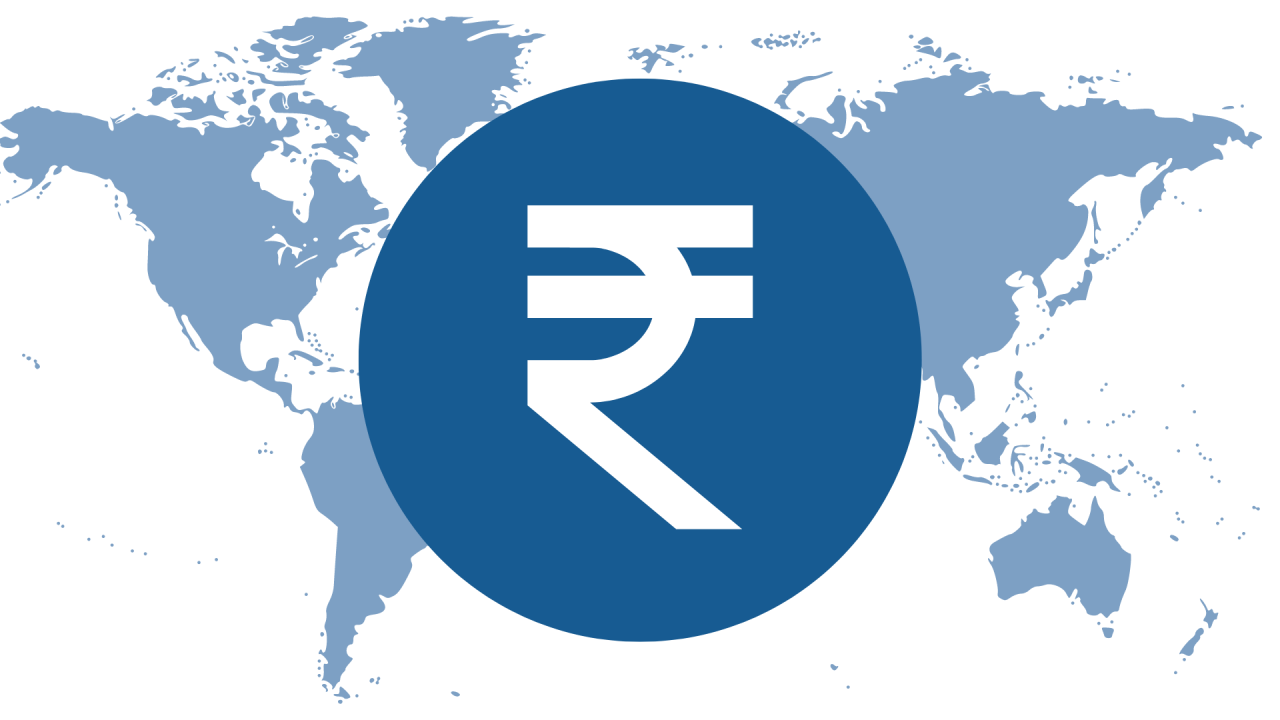Abstract
This paper tries to examine the journey of the Indian rupee towards its internationalisation and provides a comprehensive analysis on the need of internationalisation, major challenges and the impact it would have on the Indian economy. It delves into the historical context of the rupee, highlighting the significant policy changes and reforms that have shaped its trajectory throughout the years. It further studies the need for internationalisation, necessary steps to be taken for it, the impact it would have on the Indian economy and the challenges faced by the Indian economy. In conclusion, this research paper attempts to provide an analysis on internationalisation of rupee, offering insights into the dynamics of India’s economic transformation and the currency`s evolving significance at the world stage.
Introduction
With the current trend of de-dollarisation, the omnipresent dollar`s hegemony has come under a threat. Even though it’s still one of the most traded currencies in the world, it can be said that its clout is slowly fading. Especially with US governments’ weaponization of the currency towards hostile nations like freezing billions of dollars worth of Russian assets, even friendly nations are taking a step back and reevaluating their dollar dependency. Many countries are looking for alternatives too, in these times, the RBI ( Reserve bank of india) recently announced that it would be promoting the INR (Indian rupee) for international trade. According to reports the RBI has granted approvals for rupee trade across 18 countries. The first foreign trade settlement occurred in December 2022 with Russia. The most recent arrangement which occurred with UAE and Malaysia which will be analysed further in this paper. Even before, earlier in the 1960s, rupee was accepted in gulf countries such as Qatar, UAE, Kuwait and Oman. Furthermore, India also had several agreements with Eastern Europe and the Indian rupee was used as a medium of exchange. But, these arrangements were terminated in the 1960s.
Foreign Exchange Policy Through The Years
Initially, foreign exchange management in the country was controlled primarily because of its limited availability. under , foreign Exchange Regulation Act (FERA) 1947, several restrictions were imposed on forex transactions which were amended in 1973 by a more rigorous and comprehensive framework. These policies underwent a major paradigm shift in the 90s due to the introduction of LPG Policies in `91 and then came FEMA ( Foreign exchange management act) in 1999. In the last three decades India has finally integrated with the world economy, it even crossed the one trillion mark in FY 2021-22. It was in the fall of 2019 that certain changes were proposed in the ongoing foreign exchange policy. Amendments in section 6 ( capital account transaction), section 46 ( power of central government to make rules) and section 47 (power of RBI to make regulation) of FEMA were proposed. These changes led to a bifurcation of decision making power between RBI and central government . after which the RBI consulting with the central government would be entrusted with drafting the debt regulations for debt instruments while the central government would do the same for non-debt instruments. Lastly it would be upto the central government to determine instruments as debt instruments. Also even though the responsibility of handling non-debt instruments would be with the central government, things such as mode of payment, attendant conditions and reporting requirements for investment in india would still be under RBIs supervision.
Internationalisation Of Rupee
Internationalisation basically means that the Indian rupee can be freely transacted by residents as well as non-residents. A currency is said to be international when it is widely accepted across the world as a medium of exchange for trade. Moreover, it can be used as a reserve currency for global trade for
imports and exports. After July 11 2022, the central bank of India allowed the international settlement of trade in Indian rupee for export and import of goods and services. With the Russia-Ukraine War and these geopolitical tensions going on this was a good opportunity to internationalise the rupee beginning with some of the smaller export partners or those who were sanctions-hit. This mechanism for international trade settlements in rupees at exchange rates determined by market means that Indian importers can make payments in rupees which would be credited to the vostro account. A Vostro account is a special rupee account in India that domestic banks hold for foreign banks in the former’s domestic currency. Indian importers on the other hand would be paid from the surplus balance in vostro accounts. Currently, according to a survey conducted by the triennial central bank US Dollar contributes to about 88.3% of global foreign exchange market turnover, other major exchange currencies include euro, japanese yen and pound sterling. India on the other hand accounts for only 1.7%. So in order to turn Indian rupee into an international currency it’s necessary to push it much farther.
Working Of A Vostro Account
There are three types of accounts held by a bank, Vostro, Nostro and Loro accounts which are derived from Italian words “your”,”our” and “their” respectively. A vostro account is an account that a bank holds in its currency for a bank in another country. Vostro account has become a renowned term since RBI announced its decision to use this system to conduct trade settlements and transactions in Indian rupee. The vostro account mechanism will allow the partner country to have an account along with correspondent banks of other countries in its own denomination. This leads to the process of trade settlement and business transactions becoming more organised and efficient. Furthermore, as countries do not have to convert their currencies into USD for transactions, it would save their conversion expenses. So it works in such a way that the bank of a partner country would come to authorised dealer banks to have a special rupee vostro account. Then the authorised dealer bank would approach foreign exchange department of the RBI for its approval and inform them about these arrangements. Indian importers conducting imports using this mechanism shall make payments in INR which would be credited in these special vostro accounts of correspondent banks in partner countries. Indian exporters on the other hand would be paid the export proceeds in INR from balances in their special vostro account.
Need For Internationalisation Of Rupee
There were multiple reasons to take this step of internationalising the Indian rupee but most importantly it is to decrease some of the pressure on the forex reserves because even though reserves help in managing exchange rate exchange rate volatility they have a cost. Like India’s reserves are borrowed funds, at market rates banks and corporates take external debt which is then invested in government securities issued by advanced economies. The rate of external debt is higher than the rate of return on reserves, thus there is a loss of income. Secondly, With using Indian rupee it will keep in check the flow of dollars and will lead to a reduction in depreciation or atleast slow it. Also, being able to invoice in indian rupees will help indian traders to achieve a better pricing for their goods and services. With the current geopolitical scenario, countries across Asia, Africa, Latin America are almost on the verge of forex volatility and shortages. With high interest rates and inflation these countries are being pushed into a state of stagflation.
Steps To Be Taken
Before the internationalisation of Indian rupee , there are some prerequisites which need to be taken care of such as existence of a deep and well-functioning domestic financial markets, a well-made legal framework for proper enforcement of contracts and stable as well as predictable macroeconomic policies. Firstly, in order to become an international currency rupee must be completely convertible and able to be used in sufficient quantities, for which there is a need for a fully convertible capital account. Currently India has a partially convertible capital account, a fully convertible capital account will lead to a greater use of rupee in invoicing as well as settlements for international trade. It will help the country in having a progressively international presence. Then allowing banking services in rupees outside India through offshore branches of banks can help in increased acceptance of rupee as an international currency. Moreover for the stability in the market all the policies can be made and tested in the regulatory sandbox environment . Lastly, efforts should be made for inclusion of rupee in the international monetary fund’s special drawing rights baskets.
Impact Of Internationalisation
We have already discussed the need for internationalisation of the Indian rupee and the steps that need to be taken but the most important thing is what would be the impact of internationalisation on the Indian economy. Presently we are at the initial stage of internationalisation. The most important point is that internationalisation is a process rather than an event which requires constant work to build up on all the initiatives taken in the past. This would eventually benefit the economy, enhance liquidity, improve financial stability but in the short-term it can also lead to limiting the independence and influence of RBI to control domestic money supply. Also, The rupee will exposed to greater exchange rate volatility which would impact the trade competitiveness, foreign investment flows and financial stability.
India-Malaysia Deal
It was on April 1, 2023 that the ministry of external affairs announced that India and Malaysia have agreed to settle trade in Indian rupees. An important point to note is that Malaysia is the third largest trading partner of India in the ASEAN regions. The union bank became the first Indian bank by opening a special vostro account with the help of its corresponding bank in Malaysia, India international bank of Malaysia. With the help of this initiative, Indian and Malaysian traders can invoice the trade in Indian rupee and thus get a better price for both goods and services traded. There is an expectation that this step will benefit the traders on both sides as Traders can even save money on currency conversion spreads.
Challenges And Way Forward
However tempting this “internationalisation of rupee” might be, it certainly comes with its fair share of challenges, like the fact that it would create several complications in terms of formulating monetary policy. According to RBI, the potential internationalisation of rupee can lead to a decrease in the RBIs ability to control domestic money supply and change the interest rates as per the macroeconomic needs of the domestic market. This simultaneous need to reach exchange rate stability and a domestically oriented monetary policy is a huge complication. It will also increase the risk of hot currency.( hot money is a short term investment strategy involving frequent movement of money from one country to another).And especially with today’s geopolitical environment with rivalries and trade protectionism, a promotion of rupee trade would prove Internationalizing the Rupee would enhance India’s economic integration with the global community, encompassing foreign trade and international capital flows.
Lastly, India’s current share in global trade is not important enough that it could be considered as a global currency. It is highly dependent on imports such as fossil fuels, gold, silver etc. so unless other countries do not have an ulterior benefit, they would not consider Indian rupee as an invoicing currency.
In order to turn rupee into a highly tradable currency, India must increase exports and imports along with several reforms which consist of capital account convertibility, deepening of financial markets in which huge financial institutions manage large scale inflow and outflow of capital.
References
Shivangi Acharya, India’s trade policy, March 31 2023
https://www.reuters.com/world/india/indias-new-trade-policy-aims-promote-rupee-trade-2023-03-31/
Debjit Sinha, Global payments in rupee: what it means and challenges July 13 2022
Kallol Bhattacharjee, India-Malaysia trade, April 1, 2023
Vaishali Basu Sharma, how feasible is RBI’s push to settle international trade in rupees, 10 January 2023
https://thewire.in/economy/explainer-rbi-rupee-settlement-international-trade
Shekhar hari kumar and Ila Patnaik, Internationalisation of rupee, 07 February 2022
https://macrofinance.nipfp.org.in/PDF/PatnaikKumar-internationalisation_of_the_rupee.pdf


📌Analysis of Bills and Acts
📌 Summary of Reports from Government Agencies
📌 Analysis of Election Manifestos

